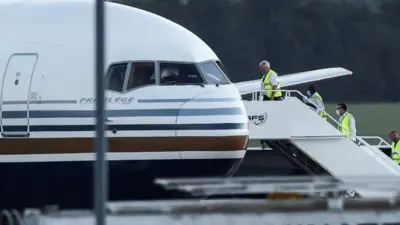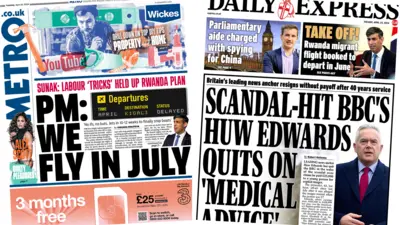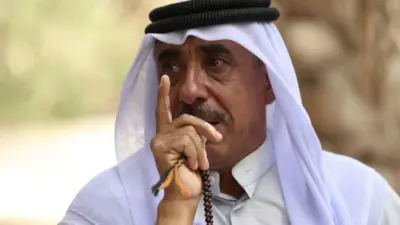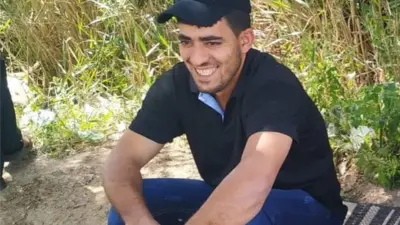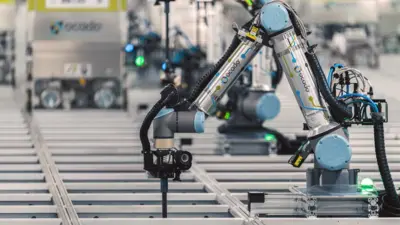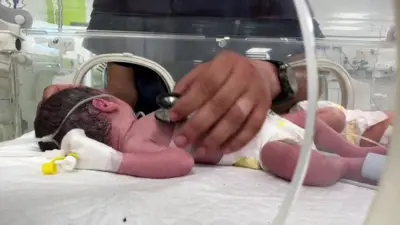We've updated our Privacy and Cookies Policy
We've made some important changes to our Privacy and Cookies Policy and we want you to know what this means for you and your data.
Saudi Arabia oil and gas production reduced by drone strikes
Saudi Arabia has cut oil and gas production following drone attacks on two major oil facilities run by state-owned company Aramco.
Energy Minister Prince Abdulaziz bin Salman said the strikes had reduced crude oil production by 5.7m barrels a day - about half the kingdom's output.
A Yemeni Houthi rebel spokesman said it had deployed 10 drones in the attacks.
US Secretary of State Mike Pompeo blamed the attacks on Iran saying there was no evidence they came from Yemen.
The Saudis lead a Western-backed military coalition supporting Yemen's government, while Iran backs the Houthi rebels.
In a statement carried by the Saudi Press Agency (SPA), Prince Abdulaziz said the attacks "resulted in a temporary suspension of production at Abqaiq and Khurais plants".
He said that part of the reduction would be compensated for by drawing on Aramco's oil stocks.
The situation was under control at both facilities, Aramco CEO Amin Nasser said, adding that no casualties had been reported in the attacks.
In a tweet, Mike Pompeo described the attack as "an unprecedented attack on the world's energy supply".
This article contains content provided by Twitter. We ask for your permission before anything is loaded, as they may be using cookies and other technologies. You may want to read Twitter cookie policy and privacy policy before accepting. To view this content choose 'accept and continue'.
End of Twitter content, 1
"We call on all nations to publicly and unequivocally condemn Iran's attacks," Mr Pompeo added.
The US would work with its allies to ensure energy markets remain well supplied and "Iran is held accountable for its aggression", he added.
Tensions between the US and Iran have escalated since Mr Trump abandoned a deal limiting Iran's nuclear activities last year and reinstated sanctions.
The Houthi spokesman, Yahya Sarea, told al-Masirah TV, which is owned by the Houthi movement and is based in Beirut, that further attacks could be expected in the future.
He said Saturday's attack was one of the biggest operations the Houthi forces had undertaken inside Saudi Arabia and was carried out in "co-operation with the honourable people inside the kingdom".
TV footage showed a huge blaze at Abqaiq, site of Aramco's largest oil processing plant, while a second drone attack started fires in the Khurais oilfield.
"At 04:00 (01:00 GMT), the industrial security teams of Aramco started dealing with fires at two of its facilities in Abqaiq and Khurais as a result of... drones," the official Saudi Press Agency (SPA) reported.
"The two fires have been controlled."
Later, the SPA reported that Saudi Crown Prince Mohammed bin Salman had told US President Donald Trump in a telephone conversation that the kingdom was "willing and able to confront and deal with this terrorist aggression".
The White House said Mr Trump had offered US support to help Saudi Arabia defend itself.
United Nations envoy Martin Griffiths described the attacks as "extremely worrying" in a statement in which he called on all parties in the Yemen conflict to exercise restraint.+
Abqaiq is about 60km (37 miles) south-west of Dhahran in Saudi Arabia's Eastern Province, while Khurais, some 200km further south-west, has the country's second largest oilfield.
Saudi security forces foiled an attempt by al-Qaeda to attack the Abqaiq facility with suicide bombers in 2006.
Production cut could hit world prices
Analysis by BBC business correspondent Katie Prescott
Aramco is not only the world's biggest oil producer, it is also one of the world's most profitable businesses.
The Khurais oilfield produces about 1% of the world's oil, and Abqaiq is the company's largest facility - with the capacity to process 7% of the global supply. Even a brief or partial disruption could affect the company, and the oil supply, given their size.
There was a sharp intake of breath as analysts I spoke to today digested the information that reports suggest that half of Saudi Arabia's oil production could have been knocked offline by these attacks.
The country produces 10% of the world's crude oil. Cutting this in half could have a significant effect on the oil price come Monday when markets open.
The success of the drone strike shows the vulnerability of Aramco's infrastructure, at a time when it is trying to show itself in its best light while gearing up to float on the stock market.
And it raises concerns that escalating tensions in the region could pose a broader risk to oil, potentially threatening the fifth of the world's supply that goes through the critical Strait of Hormuz.
An attack method open to all
This latest attack underlines the strategic threat posed by the Houthis to Saudi Arabia's oil installations.
The growing sophistication of the Houthis' drone operations is bound to renew the debate as to where this capability comes from. Have the Houthis simply weaponised commercial civilian drones or have they had significant assistance from Iran?
The Trump administration is likely to point the finger squarely at Tehran, but experts vary in the extent to which they think Iran is facilitating the drone campaign.
The Saudi air force has been pummelling targets in Yemen for years. Now the Houthis have a capable, if much more limited, ability to strike back. It shows that the era of armed drone operations being restricted to a handful of major nations is now over.
Drone technology, albeit of varying degrees of sophistication, is available to all - from the US to China, Israel and Iran - and from the Houthis to Hezbollah.
Who are the Houthis?
The Iran-aligned Houthi rebel movement has been fighting the Yemeni government and a Saudi-led coalition.
Yemen has been at war since 2015, when President Abdrabbuh Mansour Hadi was forced to flee the capital Sanaa by the Houthis. Saudi Arabia backs President Hadi, and has led a coalition of regional countries against the rebels.
The coalition launches air strikes almost every day, while the Houthis often fire missiles into Saudi Arabia.
Mr Sarea, the Houthi group's military spokesman, told al-Masirah that operations against Saudi targets would "only grow wider and will be more painful than before, so long as their aggression and blockade continues".
Image source, EPA
Houthi fighters were blamed for drone attacks on the Shaybah natural gas liquefaction facility last month, and on other oil facilities in May.
There have been other sources of tension in the region, often stemming from the rivalry between Saudi Arabia and Iran.
Saudi Arabia and the US both blamed Iran for attacks in the Gulf on two oil tankers in June and July, allegations Tehran denied.
In May four tankers, two of them Saudi-flagged, were damaged by explosions within the UAE's territorial waters in the Gulf of Oman.
Tension in the vital shipping lanes worsened when Iran shot down a US surveillance drone over the Strait of Hormuz in June, leading a month later to the Pentagon announcing the deployment of US troops to Saudi Arabia.
Top Stories
Features & Analysis
Most read
Content is not available

